by chris ayres | Mar 2017 | UK to New Zealand
I was a little surprised how green was the island after all I had read. Plenty of trees and vegetation, but then I suppose it was the rainy season.
First thing after anchoring was a dive over the side to check the bottom of Sea Bear, it had accumulated a crop of goose barnacles so those were scrapped off. A big boxy fish (puffer fish) came along to help, tugging them off and eating them.
Formalities took some time to complete, it all has to be done through an agent . At one time there were 6 official aboard plus a diver inspecting the hull. It was all very friendly though and no problems although expensive, I just had to be fumigated in the morning. For that I had to be off the ship for 3 hours so I explored the town, watched the sea lions, swam at the beach and found a nice restaraunt for a 4$ fish meal.

Wreck Bay
Subsequent days saw me walk to the beach and Lobelia for my first sight of marine iguanas, more sea lions of course, this place is ruled by sea lions. Birds including the famed finches, a lava heron, white checked pintails, oystercatcher, a plover and of course plenty of pelicans and frigate birds.
Another day I took the bus (they only run on a Sunday) across the island passing through the farming area of El Progresso to La Galapaguera, a breeding project for giant tortoises a walk around here and then on to Puerto Chino, the end of the road and a walk to another lovely beach. No sign of a bus back so after a long wait I rode back in the back of a pickup truck which is what all the taxis here are.
Boat maintainance carries on, this time it is major re-stitch of the seams of the spray hood where the stitching has either frayed through or rotted by sunlight and sea air. Its hard awkward work.
There is only the one road so some days later I rode my bike up past the highest point, Cerro San Joaquin (896m) to El Junco where I walked up to see the crater lake. That was some hard ride but much easier freewheeling back downhill. I got soaked in a downpour but you don’t get cold here near the equator so it barely matters.
Leaving Sea Bear at anchor I took a launcha (fast motorboat with 3 big outboard engines that do the 40 nm trip in about 2 hours) over to Puerto Ayora, Santa Cruz to meet up with my son Ged who flown into the Galapagos. We visited the Darwin centre and walked to Turtle bay then managed to arrange a few days on a tourist boat. This was very good indeed, food superb and the wildlife guide very knowledgable and informative. We visited giant tortoises in the highlands of Santa Cruz then the boat took us overnight to island of Espanola where we walked ashore on Gardner bay for sea lions and marine iguanas, snorkeled in the bay seeing turtles. On then to Punta Suarez for a walk across the peninsular though marine iguana breeding sites and masked booby colonies.
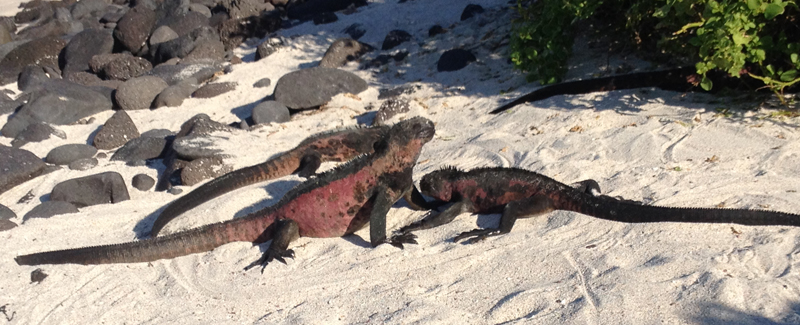
Marine Iguana

Gardner Bay Española

Land Iguana Santa Fe
Even though it was a little early in the season we were lucky to see one waved Albatross.
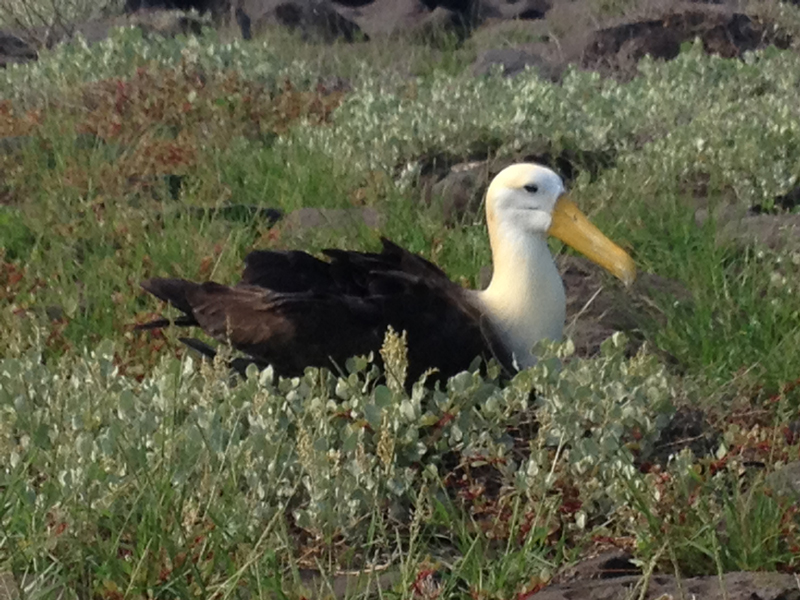
Waved Albatross
One of the features of the Galapagos is the fearless nature of all the wildlife meaning that you can approach really close which is very special. Here we also saw the Galapagos hawk.
Next was island of Santa Fe for the cactus trees and land iguanas found only on this island. Then to South Plaza, a different type of landscape, a different type of iguanas plus nesting on the cliffs, swallow tail gulls, blue footed boobies and Audubon’s shearwaters. Throughout there were frigate birds , tropic birds, finches, mockingbirds and Galapagos doves.
Tour finished we bussed over Santa Cruz to Puerto Ayora and Ged and I returned by launcha to San Cristobal to rejoin Sea Bear.
We had a fabulous snorkel in a rocky cove underneath Cerro Tijeretas with big schools of fish, many brightly coloured big fish and with sea lions swimming really close to you.
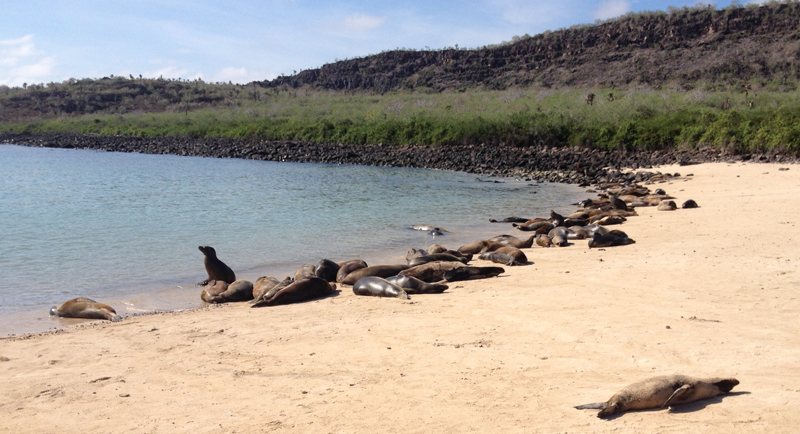
Sea Lions
But my time in the Galapagos is up, it has been fabulous, but now its time to arrange my zarpe, clear immigration, stock up with water, veg, fruit and bread and head on out for the Marquesas. They are about 3,000 mile away so 30 days or more.
by chris ayres | May 2017 | UK to New Zealand
I had a what I think to be a very slow passage following just about the great circle route which differs not a lot in these latitudes from the rhumb route. I’ll not bore you with the full details but I can understand why Connor O’Brien, who was the first Irish yacht circumnavigator, said if he had to sail 5,000 miles in the trade winds that he would die of boredom. Still as the great Moitessier said, cruising is one long game of patience.
I’ll just add trade winds what trade winds! The pilot books had assured me I would be gently wafted from Galapagos to the Marquesas by the SE trades
Leaving the Galapagos I had no wind then a succession of squalls , one which caught me unawares on a grey drizzly morning when the wind went from 10 knots to 35 – 40 in a matter of moments and torrential rain. It was one of those moments which bought to me how alone you are out here and far away from any help. Then the weather improved for some days but I still had a series of grey overcast days with no sight of the sun. The winds were light many days of 8- 9 knots of wind and sometimes lower. At first they were indeed from SE, living up to their name and we could sail along on a broad reach but then they went E even NE so it was dead downwind, a point of sailing that neither Sea Bear nor I agree to like and there was always enough swell to create at times, lively rolling which was tiresome.
It amazed me how quickly weed and barnacles grow on the bottom in these waters. I had started out clean but after a week already had a fair growth and it doesn’t take too much to slow the boat down and make her sluggish and unresponsive on the helm. One day when the wind was only 3 knots i did launch the dinghy and try and scrape some away but there was too much swell and I adjudged it too dangerous.
There is very little boat traffic this way and I only saw 3 boats, one a freighter and two fishing boats, still with a guard alarm set on AIS it does mean you can get some decent sleep.
The last few hundred miles seemed to take forever, I think i know what its like to be in limbo now.
The penultimate day around midday I spied land, at first not quite sure, was it cloud but no a bit later I was certain Land Ho. The Marquesas are high mountains and I was still 45 miles off.
There was no chance to get in before dark that night so when about 20 miles of I hove too and drifted slowly towards them. Dawn I let draw again, what magnificent islands steep mountainous and verdant and largely unspoiled.
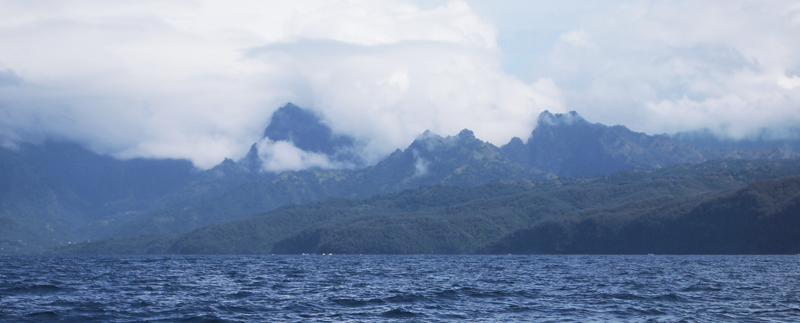
Approaching Hiva Oa
Later as I turned into Atuona Bay, Hiva Oa, I met with Thom on another Vancouver 28 just leaving.
I anchored in the bay, I had made it to one of the most remote group of inhabited islands in the world, Gauguins paradise.
2995 nmiles and 34 days
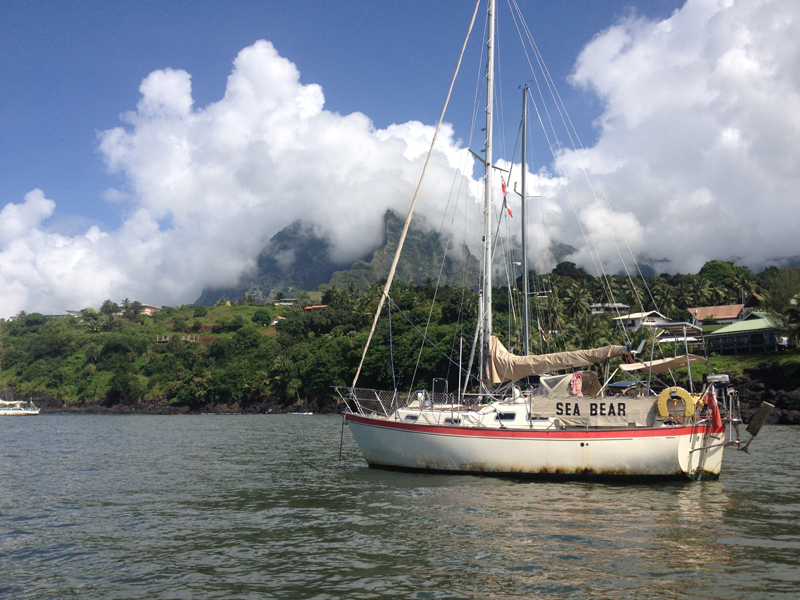
At anchor Atuona Hiva Oa
by chris ayres | May 2017 | UK to New Zealand
Hiva Oa
Always the first job once the boat is securely anchored is to register with the Authorities. A walk of about 3 kilometers took me to the town of Atuona. At the Gendamarie I discovered that the time zone here is half hour different not 1 hour which is the usual step in time from one zone to another, and the place was shut until after lunch. At that prompt a visit to an ATM saw me furnished with funds, but I had no idea of the exchange rate, although the Polynesian Franc notes were very colourful and pretty, and I could have lunch myself, a real treat after so long on the boat.
Later formalities were initiated very easily, but I had to post the form the Gendarmes gave me to Papete, Tahiti where I would have to visit to complete things when I got there.
Next a visit to the shops and a real treat in baguettes and french cheese, that would go well with my last bottle of french wine as a celebration of arrival. Ooh and some tins of cold Tahitian beer, one drunk on the spot, perhaps thats why the walk back to the boat seemed so long.
I spent a few days at Atuona, looking around and enjoying land.

stone carvings at Atuona
A river emptied into the anchorage bay and it rained a lot meaning the water was very muddy but one benefit of this was that all the fresh water killed off the goose barnacles and weed on the hull.
Fatu Hiva
Leaving Hiva Oa it was about full moon I thought to have a pleasant moonlit sail to Fatu Hiva. At about 45 miles away it was just to far to guarantee managing all in daylight. It is one disadvantage of sailing in the tropics 12 hour days and 12 hour nights. As it was it turned out very cloudy.
Arrived in Baie Hanavave or Bay of the Virgins, a truly spectacular anchorage, steep sided and dominated by rock pinnacles and behind a backdrop of steep high mountains.

Baie Hanavave
The island is very unspoilt and the people super friendly. Went to a dinner of traditional fare for cruisers anchored in the bay hosted by a family from the village. Roast pork, roast goat, breadfruit, coconut milk, roasted pink bananas & pamplemousse was amongst the items on offer.
One day a walk took me to a lovely 200 ft waterfall up the valley behind the village where I skinny dipped in the plunge pool, very refreshing. Another walk took me high above the bay looking down on the boats at anchor.
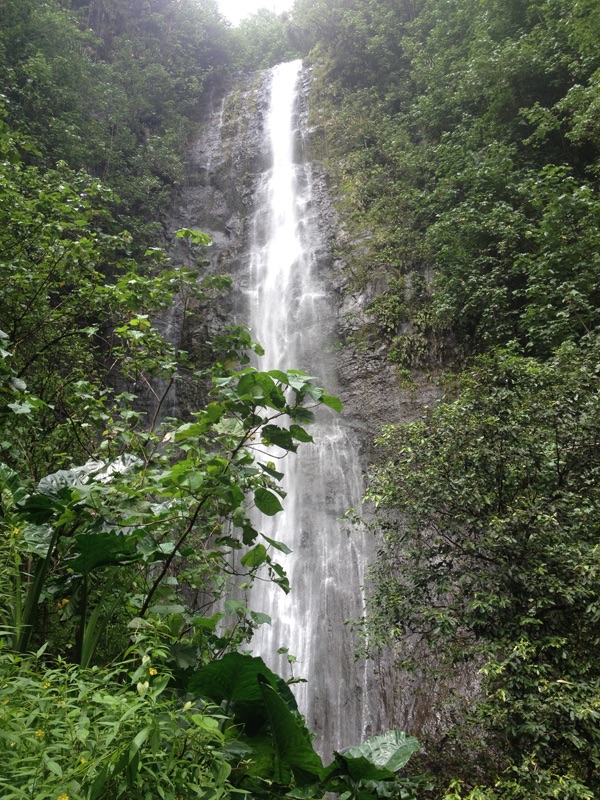
Waterfall at Fatu Hiva
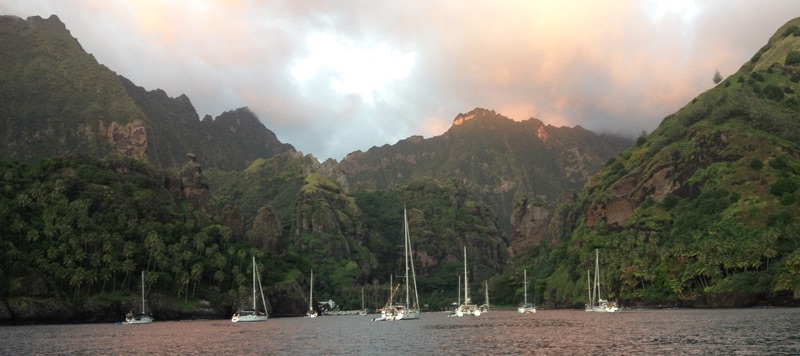
Leaving Bay of Virgins
Tahuata
Another night sail took me to Tahuata where I anchored at Baie Hanamoenoa, reckoned by one authority to be one of the 3 most beautiful anchorages in Polynesia. An uninhabited bay with a yellow sand beach back by coconut palms and a backdrop of green hills. Very soft and gentle by Marquesian standards I thought.

Baie Hanamoenoa
From there I thought to visit a bay on the North coast of Hiva Oa, said to be good for ancient Polynesian sites however after all the light winds I had a day of very strong wind with a big breaking swell so it was not to be and halfway there I changed my objective and headed across the 80 miles to Nuku Hiva. A fairly rolly polly night but an early morning arrival in Taiohae bay. I anchored next to Thom’s Vancouver28.
by chris ayres | May 2017 | UK to New Zealand
19th – 25th May Taiohae bay
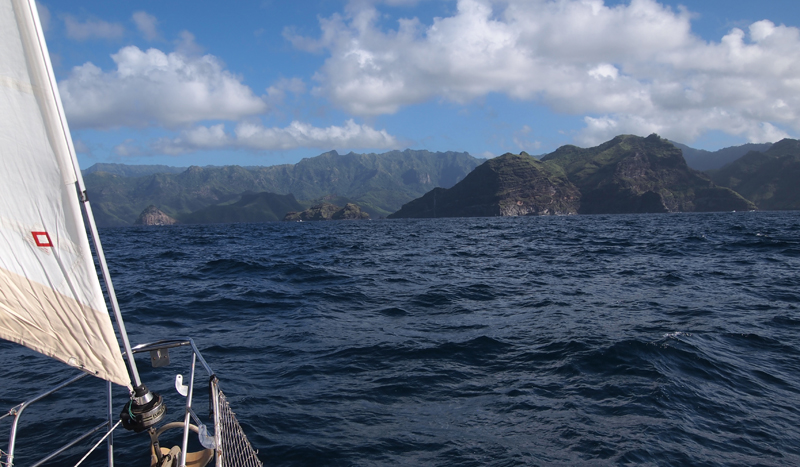
Then bay is very big and able to accommodate lots of yachts at anchor so is a major gathering point in the Marquesas for cruisers. The town ashore is the biggest in the Marquesas so there are shops, a bank, restaurants etc so it is a good place to re-provision and relax. However all the supplies come in by boat which was due in a few days, in between shipments they do run out of things so for the first few day here the shelves were thinly stocked and they had run out of flour so there was no bread to be had.
Thom was anchored here so it was good to catch up and compare notes as it were on our Pacific passages so far. We also looked over each other boats which although the same model had a few differences in layout and set up.
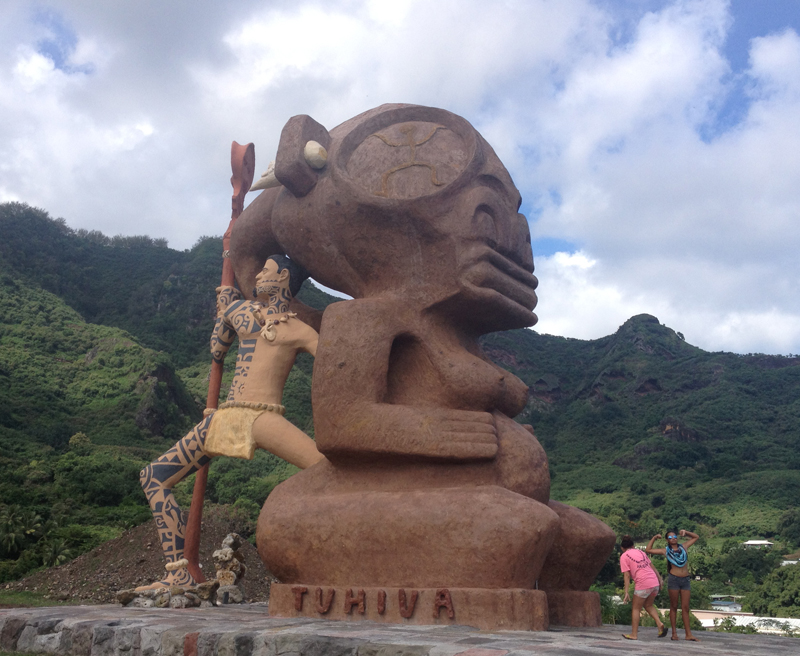
Tuhiva
There were also here some other cruisers that I had got to know so it was a fairly sociable time.
Whilst here I took a few local walks and had a second go at repairing my leaky dinghy not entirely successfully.
26th-29th May – Baie Tai’oe
My next move was to another bay about 5 miles along the coast, Baie Tai’oe. The entrance to this was hidden and looked rather improbable at first entering between a rocky point with breaking waves and tall vertiginous cliffs and with quite a swell running a trifle daunting.
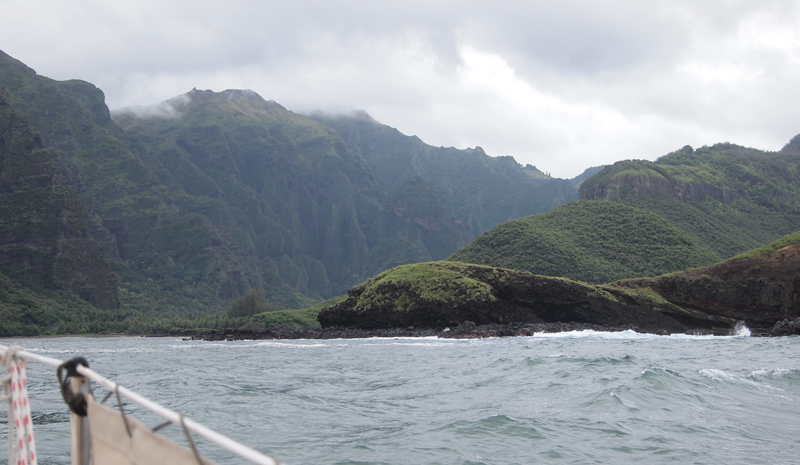
Entrance to Taioa bay
Once inside though it was sheltered, calm and peaceful and you couldn’t even see the ocean.

Taioa bay
Thom arrived next day with a new crew member for me. I had mentioned the other day when a group of us had a pizza together that I was a bit concerned about passing through the Toumotus or Dangerous Archipelego without a crew to watch for reefs and coral heads in the passes and here almost out of the blue was a volunteer to come with me.
Beside the spectacular scenery of this bay, one of the attractions was the 3rd highest waterfall in the world being up the valley. Next day I dinghied around to the village of Hakaui, population 10, and walked up the trail to Vaipo falls. The trail was wet and muddy and you had to ford a knee deep fast running river. You were rewarded with a wonderful view at one point before pushing on through the forest.

Vaipo falls
All around were the ruins of ancient paepae or house platforms, at one time the valley must have supported a large population.
I got back to the village before it started raining then had an exciting time going back out through the surf to the boat, thought I might get flipped but just took a wave aboard.
Went back to th e village next morning and filled my water cans and bought a whole load of fruit, a hand of bananas, pamplemousse, limes and a breadfruit
by chris ayres | Jun 2017 | UK to New Zealand
Weighed anchor early from Baie Taiohae and set of for the island of Oa Pou about 25 miles away. We were rewarded with blue skies and moderate winds and a fairly calm sea so had a nice sail across.
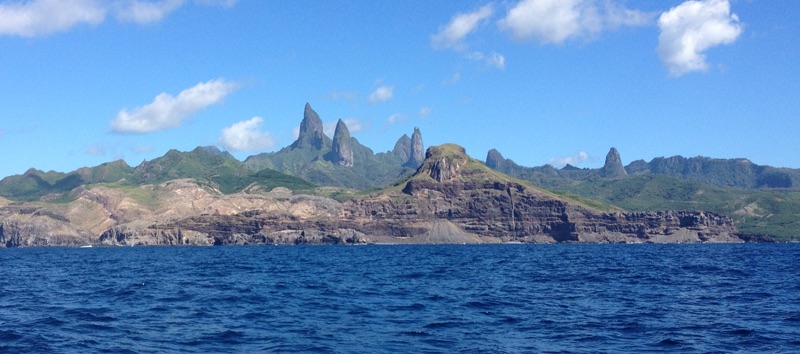
Approaching Oa Pou
It is very dramatic island with tall rock spires, the tallest is Mt Oave, a volcanic plug at 4,004 feet high. There was hardly any cloud when we approached so we could see them in all their splendour but since they have been hidden in the cloud.
Hakahau with a population of about a thousand is the 3rd most populated village in the Marquesas, but feels a sleepy little place. We are anchored in the bay behind the breakwater which gives some protection from the swell.
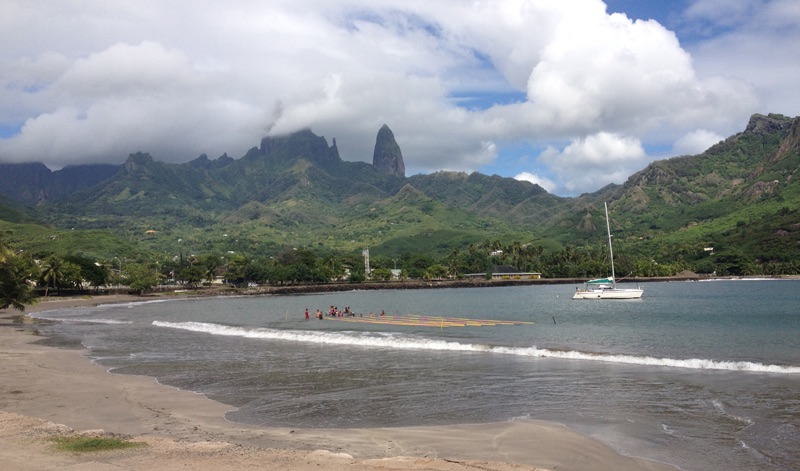
Baie Hakahau
This will be the jumping off spot for the Toumotos about 450 miles away and we will set off when the weather looks suitable last night was very windy and it has kicked up quite a sea outside so we will wait for that to settle before making passage.
by chris ayres | Jun 2017 | UK to New Zealand
Mixed weather for the 450 mile passage to the Toamotos with very variable winds in strength and direction from SE to NE and 3 days of very cloudy grey conditions. However it was never too windy nor too rough so no complaints on that score. Another passage with no sightings, no dolphins, no whales and just one fishing boat as we closed on Ahe in the early hours of the last morning. Our trailing of a fishing line proved unsuccessful too. We managed to hook two, both reel screamers, both big but the first just bent the hook and the second broke the line like it was a piece of week cotton.
The Toamotos earned their reputation as the Dangerous Isles because the Motos & coral reefs are so low lying and hard to spot and we did not sight Ahe until we were about 5 miles away, a thin line of coconut trees fringing the horizon.

The outside reef Ahe
On Ahe there is just one pass into the lagoon, about 85 fett wide at its narrowest and just 3-4 metres deep over the bar. Through this rushes all the water in and out of the lagoon with the tides so a slack water passage is recommended. Only having the tide times for another atoll Rangiroa about 90 miles away we had to guess and rely on the look of the water. Motoring in we had about 2-3 knots of tide against us, so slow progress but plenty of steerage way. Once inside over the bar current slackened and we could follow the marked channel across the lagoon to anchor off the village of Tenukapara.
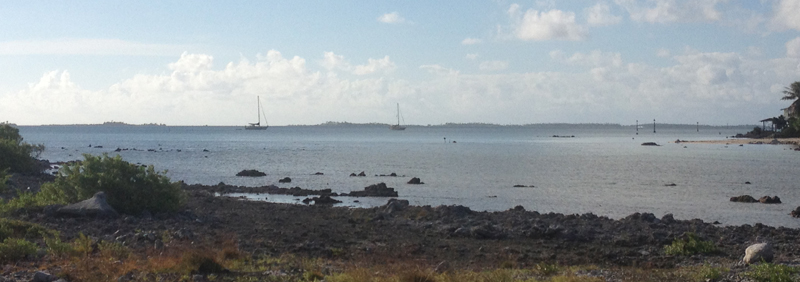
In the lagoon Ahe
Even though Ahe is one of the smaller atolls the lagoon feels vast inside and strange to be encircled by all the islets which comprise the rim. Strange too that night when the boat was so peaceful on the anchor, so still, no rocking or rolling, it was hard to remember when the boat had last been that quiet aboard, the San Blas Islands I think back in January.

Ahe
The people in the village are super friendly. I was outside the PO and a women asked if I had any music. She rushed off for a memory card and I put a lot of reggae on it for her. She gave me a whole load of bananas.
Off to another atoll in the morning.






















